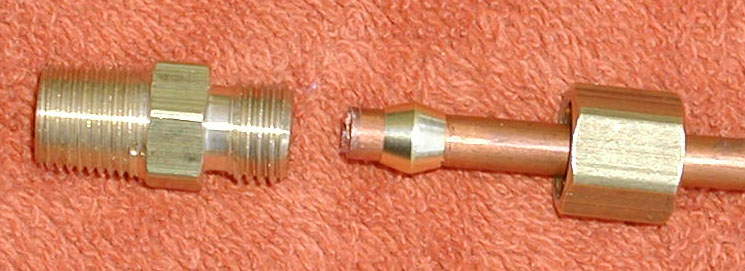This is a pic of a compression fitting attached to a piece of copper tubing. The three brass parts are the compression fitting.
When you buy it, it will be three separate parts. The part on the left is called the 'seat'. The little round part in the middle is called the 'ferrule' or 'ring'. The part on the right is called the 'nut'.
You can get seats that are shaped a bunch of ways. Male pipe threads (like pictured), female pipe threads, male with 90* bend, female with 90* bend, etc, etc.
You want to make sure you buy a compression fitting that has the proper pipe threading to attach to your bulkhead and a ring and nut that is the proper size to fit around the copper you are using for the diptube.
To install a compression fiting. Slide the nut onto the copper, then slide the ring onto the copper. Then begin to screw the nut onto the seat, making sure your copper tubing stays inserted fully into the thing.
The nut freele swivels around the tubing. As you tighten the nut, it will compress the ring, and the ring will become clamp down onto your copper tubing. The ring will become permanently attached to the tubing. Don't over tighten the nut onto the seat. Just do it until the ring is clamped on good.
Now you have a copper tube that is attached, liquid tight, to the brass seat pipe fitting. The nut still swivels freely, so if you unscrew it from the seat, you will be able to pull the copper tubing (with clamped on ring) out of the seat.
You will end up screwing the seat into your bulkhead and just leaving it there. To install the diptube, insert the copper into the seat and screw down the nut.
To uninstall the diptube, unscrew the nut from the seat.


